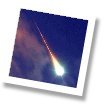Large meteors and their shades of colour
Large meteors and their colours By experience we can say at this point, that only meteors with a definite brightness (from about magnitude of a fireball) one can see with colours. All faint phenomena are colourless for our eyes or will be described as whitish or sometimes yellowish objects. But also the extremely bright bolides will be often described as rather whitish objects, because apparently our eyes are overstressed. Most splendid and richly coloured is the glowing of the fire meteors at the night sky. These meteors can show successively the whole light spectrum. Colour photographs from a camera or a video indicate very clearly the dynamic colour changes of a meteor, which are dependent on the flying altitude and the forms of appearance of the respective phenomenon. The recording of spectra of those infrequent and spectacular events is still in the fledgling stages, because there is a lack of suitably bright meteors and consequently experiences.
A meteor phenomenon: Fireball Above all other light phenomena are those events worthy of mention, which are glowing at the sky in a more green or blue or turquoise manner. These colours we can observe very frequently. Apparently you can identify the collision plasma of the shock wave front very well with this type of meteors. Just that spherical meteor, which is often described as a fireball, is glowing with an unsettled flickering light, which is featuring these distinctive shades of colours. They are often compared with the electric arc associated with the electric welding. There are also fireball events with distinctive yellow colours, which in combination also are sparking reddish sparks. An earth grazer however generally lights up only as thick reddish spot, when he was still very high. But even this meteor can become to a fire meteor, if the intruder is large enough to deeply penetrate the atmosphere.
Meteors with tails The so-called fire meteors are for that reason so colourful, because mostly they generate a bright orange meteor tail. Directly behind the collision plasma, which is located in the front section of the meteor, still another plasma field can evolve. That is the so-called combustion plasma, which is not quite as bright as the head of the meteor. The backward flowing plasma phase can appear a white yellow colour at the tail intersection to an orange or reddish brown colour at the tail end.
The end of the light appearance In the end we can observe an intense change of colors at some meteor events. The meteor is changing its colour rapidly in dark red or shades off into white or colourless. If you would observe a meteorite fall event by chance at night, in which it comes to a break up of the intruder, then, after a bolide-like flash at the end, several light spots in a warm golden yellow to red light (which are drifting apart and apparently burn up) still should move a certain distance in the firmament. This would be the real glowing of the generated meteorites, which will get the fusion crust just at that moment. | ||||
 | ||||
Meteoric Science

![]()
![]()


![]()






